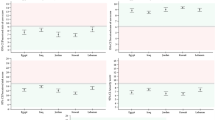Abstract
Chat is one of the Internet’s services that have had a particularly strong influence on young people, and its effects on their skills development is worthy of investigation. This study focuses on the possible consequences of the use of Chat on cognitive processes. More specifically, it evaluates the impact of frequent Chat use on the development of memory and on cognitive style. This research, exploratory in nature, began with an instrument for classifying 125 students in 5th to 8th grade at schools in Chile, according to their Chat use. We then applied a memory and attention test based on the Digit Span Subtest of the Wechsler Intelligence Scale for Children, followed by a Group Embedded Figures Test to evaluate cognitive styles. The results show that there are significant differences on both tests between frequent and infrequent users of Chat services.
Preview
Unable to display preview. Download preview PDF.
Similar content being viewed by others

References
Baddeley, A.D., Hitch, G.J.: Working Memory. In: Bower, G.A. (ed.) Recent Advances in Learning and Motivation, vol. 8. Academic Press, New York (1974)
Castells, M.: La Era de la Información: Economía, Sociedad y Cultura. Alianza, Madrid (2000)
Dimaggio, P., Hargittai, E., Russell, W., Robinson, J.P.: Social Implications of the Internet. Annual Review of Sociology 27, 307–336 (2001)
Fernández, F., Goldenberg, S.: WIP Chile: Scanning the Reality of Internet in Chile. Revista Universitaria 84, 14–16 (2004)
Green, S., Bavelier, D.: Action Video Game Modifies Visual Selective Attention. Nature 423, 534–537 (2004)
Grinter, R., Palen, L.: Instant Messaging in Teen Life. In: Conference Proceedings on Computer Supported Cooperative Work - CSCW. Association For Computing Machinery. ACM, New Orleans (2002)
International Telecomunication Union: Internet Indicators: Hosts, Users and Number of PCs. Geneva (2004), http://www.Itu.Int/Itu-d/Ict/Statistics/Index.html
Isaacs, E., Kamm, C., Schiano, J., Walendowski, A., Whittaker, S.: Characterizing Instant Messaging from Recorded Logs. In: Conference Proceedings on Human Factors in Computing Systems. Association for Computing Machinery - ACM, Minnesota (2002)
Lenhart, A., Rainie, L., Lewis, O.: Teenage Life Online: The Rise of the Instant Message Generation and the Internet’s Impact on Friendships And Family Relationships. Pew Internet and American Life Project, Washington (2001), http://www.pewinternet.org/
Lenhart, A., Shiu, E.: How Americans Use Instant Messaging. Pew Internet and American Life Project, Washington (2004), http://www.pewinternet.org
Li, X., Atkins, M.: Early Childhood Computer Experience and Cognitive and Motor Development. Pediatrics 6(113), 1715–1722 (2004)
Luna, R.: Un Análisis Sobre la Relevancia de las Interacciones entre Estrategias Cognitivas y Modalidades de Procesamiento. Anales de Psicología 16(1), 61–77 (2000)
Marín, R.: Un Estudio Acerca de la Dimensión Estilo Cognitivo Dependencia-Independencia de Campo en Escolares Básicos de la Región del Bio-Bio Chile. M. Sc. Thesis, Escuela de Educación, Universidad Católica de Chile, Santiago (1988)
Meyer, D., Rubistein, J., Evans, J.: Executive Control of Cognitive Processes in Task Switching. Journal of Experimental Psychology: Human Perception and Performance 27(4), 763–797 (2001)
Ministerio de Educación: Sistema de Medición de la Calidad de Educación 2002 4° Básico. Editor, Santiago (2003), http://www.simce.cl
Miyake, A., Sha, P.: Models of Working Memory: Mechanisms of Active Maintenance and Executive Control. Cambridge University Press, Cambridge (1999)
Nardi, B., Whittaker, S., Bradner, E.: Interaction and Outeraction: Instant Messaging in Action. In: Proceedings on Computer Supported Cooperative Work- CSCW, Association for Computing Machinery. ACM, Philadelphia (2000)
Nilesen Net Ratings: Internet Audience Measurement Service (2000), http://www.Nielsen-Netratings.com
Nua Internet Surveys: How Many on Line (2004), http://www.nua.ie/surveys
Nie, N., Simpser, A., Stepanikova, I., Zheng, L.: Ten Years After The Birth of the Internet, How Do Americans Use the Internet in Their Daily Lives? Stanford Center for the Quantitative Study of Society, Stanford (2004), http://www.stanford.edu/group/siqss
Organisation for Economic Co-operation and Development – OECD: Understanding the Digital Divide. Editor, París (2001)
Valsiner, J., Van Der Veer, R.: The Social Mind: Construction of the Idea. Cambridge University Press, Cambridge (2000)
Vygotsky, L.: The Development of Higher Psychological Processes. Harvard University Press, Cambridge (1978)
Warschauer, M.: Technology and Social Inclusion: Rethinking the Digital Divide. Massachussets Institute of Technology, Massachusetts (2003)
Weschler, D.: Wechsler Intelligence Scale for Children – Revised. Psychological Corporation, San Antonio (1981)
World Internet Project Chile: Síntesis de Resultados Wip Chile 2004. Instituto de Estudios Mediales UC, Santiago (2004), http://www.wipchile.cl
Witkin, H., Goodenough, D.: Cognitive Styles: Essence and Origins Field Dependence and Field Independence. International University Press, New York (1981)
Yus, F.: Ciberpragmática: El Uso del Lenguaje en Internet. Ariel, Barcelona (2001)
Author information
Authors and Affiliations
Editor information
Editors and Affiliations
Rights and permissions
Copyright information
© 2005 Springer-Verlag Berlin Heidelberg
About this paper
Cite this paper
García, L., Nussbaum, M., Bolton, J. (2005). Correlations Between Digital Tools and Humans Cognitive Processes. In: Shimojo, S., Ichii, S., Ling, TW., Song, KH. (eds) Web and Communication Technologies and Internet-Related Social Issues - HSI 2005. HSI 2005. Lecture Notes in Computer Science, vol 3597. Springer, Berlin, Heidelberg. https://doi.org/10.1007/11527725_34
Download citation
DOI: https://doi.org/10.1007/11527725_34
Publisher Name: Springer, Berlin, Heidelberg
Print ISBN: 978-3-540-27830-6
Online ISBN: 978-3-540-31808-8
eBook Packages: Computer ScienceComputer Science (R0)



